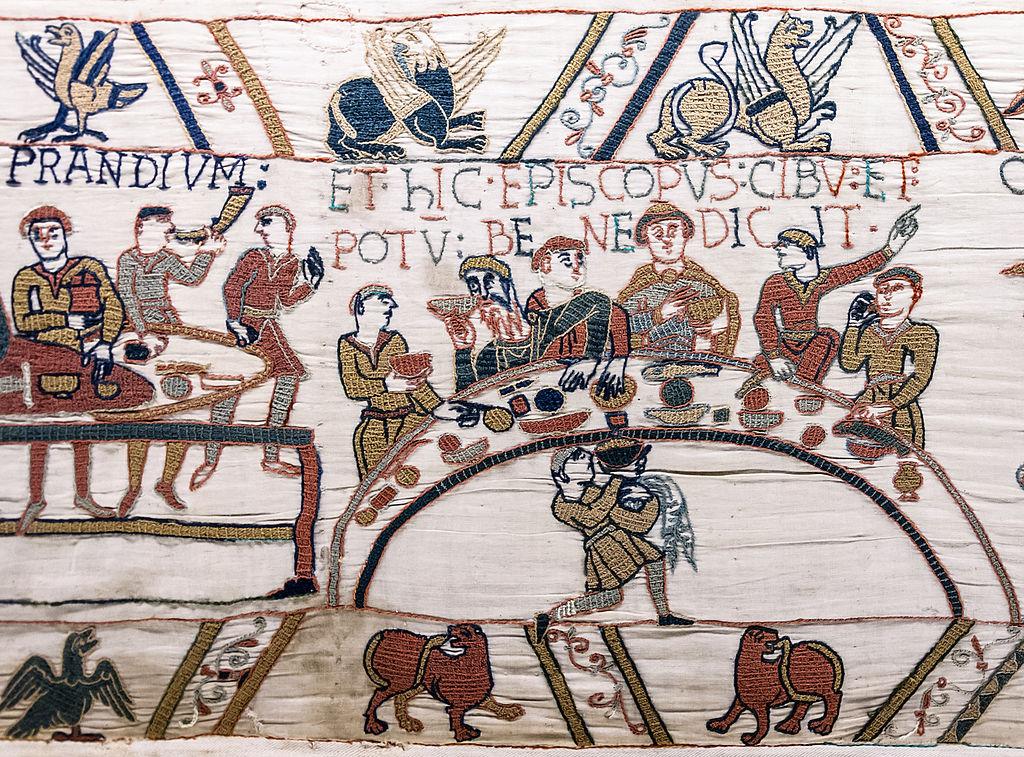Note: This article has been excerpted from a larger work in the public domain and shared here due to its historical value. It may contain outdated ideas and language that do not reflect TOTA’s opinions and beliefs.
England to 1500
I. Saxon England.
Foods.
a. Meats and fish staple in diet, huge quantities being consumed. Customary to roast beeves whole.
b. Fowl esteemed and raised for table; wildfowl considered delicacies.
c. Few vegetables known; cereals (barley, corn, rarely wheat) ground for bread; acorns commonly used as meal by poor.
d. Liquor distilled from grain the common drink, even among rulers. Mead, made from honey, favorite drink.
Table customs.
a. Huge feasts, to celebrate battles or as signs of good will, frequent occurrences.
b. Men and women sat at table together, ranged according to rank, all sitting at same board.
c. Dishes and utensils rude—cups of horn, dishes of wood, meat served on spits on which it was roasted; no forks, but each guest brought his own knife. Table cloths used, but not napkins.
d. Heavy drinking the rule. Singing and professional jesting the entertainment. The bard improvised verses in honor of giver of feast.
Architecture.
a. Dining hall largest room in the one-story structure. Table simply boards laid on trestles, removable when not in use. Guests sat on benches without backs.
b. Kitchen early separated from dining hall, built around chimney, where all cooking was done before open fire.
II. Norman England.
Foods.
a. Greater refinement at once came in with the more cultured Normans. Cookery for first time in England regarded as an art. Flavor and delicacy more esteemed than mere quantity, as among Saxons. With this period comes influence of Crusades, with its importation of Eastern fruits, as citron, cloves, lemons, oranges, figs, and dates, and its spices for preserving meats through winter. Norman nobles brought their own stewards and cooks, and these positions became posts of honor in household.
b. Drinks. Upper classes used wines almost entirely; despised beer, ale and mead, which continued to be beverages of common people. Heavy drinking still customary with both classes. Cider popular beverage,
c. Vegetable foods much more common than in Saxon period.
Architecture.
a. Dining hall. Gothic architecture, with high arched roof and gallery at one end. Long ceremonial table, with raised table on dais across end where master and distinguished guests sat. Elaborate ceremony of service.
b. Divisions of kitchen, with pantry, buttery, etc.
Derivation of our words to-day from
a. Anglo-Saxon terms, i.e.. Lord, Lady.
b. Norman terms for foods, i.e., beef, veal.
c. Monastic divisions of labor, i.e., butler, steward.
Sports and occupations.
a. Hunting. Wild deer, boar, hare, etc., hunted and kept in preserves.
b. Hawking. Sport of nobility in Norman England. Hawks used to bring down small birds, used as food and esteemed as delicacies.
c. Fishing. Occupation rather than sport; nobility seldom engaged in it, though seafood was staple of diet.
III. Picture of English in Chaucer's Day.
1. Monastic fare. Prologue to Canterbury Tales.
2. Traveller's fare, at inns.
3. Fare of gentlefolk, description of Merchant and of Cook.
4. Table manners, description of Prioress.
IV. Appearance of Books of Cookery.
1. Treatise on Cookery, 1375, by Guillerant, cook to Charles V.
2. Forme of Cury, 1390, in England, by cook to Richard II.
3. De Honesta Voluptate et Valitudine, 1474, in Venice.
4. De Re Culinaria, CoUius Apicius, 1498.
5. The Noble Boke of Cookery, 1500, in England.
6. Boke of Kervynge, Wynkyn de Word, 1513, in England.
7. Kuchenmeistery, Strassburg, 1516.
8. Manual by Scappi, privy cook to Piux V, 1622.
9. Proper Newe Boke of Cookery, England, 1570.
10. The Good Housewife's Treasury, England, 1588.
Barrows, Anna, and Bertha E. Shapleigh. Outline on the History of Cookery. Teacher's College, Columbia University, 1915.
About TOTA
TOTA.world provides cultural information and sharing across the world to help you explore your Family’s Cultural History and create deep connections with the lives and cultures of your ancestors.


